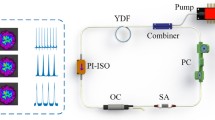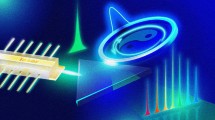Abstract
We report on the longitudinally pumped tunable single- and dual-wavelength nanosecond Ti:Sapphire laser operation around 765 nm by using a Brewster-cut single Ti:Sapphire crystal in combination with an intracavity prism and etalon. Tilting the etalon to a specific angle, single-wavelength operation at 767.9 nm is achieved first, with a maximum output power value of 1.3 W below 5.5 W pump power. Then, increasing the pump power leads to simultaneously operation at dual wavelength (765.0, 771.3 nm), (763.9, 772.2 nm), (763.5, 772.2 nm), and (762.4, 773.7 nm) with a maximum output power of ~ 2.98 W, pulse width of ~ 20 ns, and a laser slope efficiency of about 34.7% at 1 kHz repetition rate. By tilting the etalon, other dual- and single-wavelength laser operations could be achieved. Experimental results show that it is tunable in the region 750–840 nm which here is limited by the reflectivity of the cavity mirrors. We observed, when laser oscillates at dual wavelength, the separation of the wavelengths increased with pump power which could be because of thermal lensing in Ti:Sapphire. The output characteristics versus incident pump power at 1 and 5 kHz repetition rate show output power increases linearly with incident pump power with similar slope for both 1 and 5 kHz repetition rates, whereas pump threshold increased in the case of 5 kHz.










Similar content being viewed by others
References
P. Hering, J.P. Lay, S. Stry (eds.), Laser in Environmental and Life Sciences: Modern Analytical Method (Springer, Heidelberg, 2003)
R.W. Farley, P.D. Dao, Development of an intracavity-summed multiple-wavelength Nd:YAG laser for a rugged, solid-state sodium lidar system. Appl. Opt. 34, 4269–4273 (1995)
A. Saha, A. Ray, S. Mukhopadhyay, N. Sinha, P.K. Datta, Simultaneous multi-wavelength oscillation of Nd laser around 1.3 µm: a potential source for coherent terahertz generation. Opt. Express 29, 4721–4726 (2006)
E. Herault, F. Balembois, P. Georges, 491 nm generation by sumfrequency mixing of diode pumped neodymium lasers. Opt. Express 13, 5653–5661 (2005)
W. Demtröder, Laser Spectroscopy: Basic Concepts and Instrumentation, 3rd edn. (Springer, Berlin, 2003)
G. Shayeganrad, P. Parvin, DIAL–phoswich hybrid system for remote sensing of radioactive plumes in order to evaluate external dose rate. Prog. Nucl. Energy 51, 420–433 (2008)
W. Li, Q. Hao, J. Ding, H. Zeng, Continuous-wave multi-wavewavelength diode-pumped Yb:GYSO laser. J. Opt. A Pure Appl. Opt. 10, 095307 (2008)
F. Wang, D.Y. Shen, D.Y. Fan, Q.S. Lu, Widely tunable dual-wavelength operation of a high-power Tm: fiber laser using volume Bragg gratings. Opt. Lett. 35, 2388–2390 (2010)
G. Shayeganrad, L. Mashhadi, Dual-wavelength CW diode-end-pumped a-cut Nd:YVO4 laser at 1064.5 and 1085.5 nm. Appl. Phys. B 111, 189–194 (2012)
G. Shayeganrad, Y.-C. Huang, L. Mashhadi, Tunable single and multiwavelength continuous-wave c-cut Nd:YVO4 laser. Appl. Phys. B 108, 67–72 (2012)
G. Shayeganrad, Actively Q-switched Nd:YVO4 dual-wavelength stimulated Raman laser at 1178.9 nm and 1199.9 nm. Opt. Commun. 292, 131–134 (2013)
C.W. Luo, Y.Q. Yang, I.T. Mak, Y.H. Chang, K. H.Wu, and T. Kobayashi, A widely tunable dual-wavelength CW Ti:sapphire laser with collinear output. Opt. Express 16, 3305 (2008)
Z. Qin, Z. Qiao, G. Xie, P. Yuan, J. Ma, L. Qian, D. Jiang, F. Ma, F. Tang, L. Su, Femtosecond and dual-wavelength picosecond operations of Nd, La:SrF2 disordered crystal laser. IEEE Photon. J. 9, 1502007 (2017)
W. Li, Q. Hao, J. Ding, H. Zeng, Continuous-wave multi-wavelength diode-pumped Yb:GYSO laser. J Opt. A Pure Appl. Opt. 10, 095307 (2008)
C.Y. Li, Y. Bo, J.L. Xu, C.Y. Tian, Q.J. Peng, D.F. Cui, Z.Y. Xu, Simultaneous dual-wavelength oscillation at 1116 and 1123 nm of Nd:YAG laser. Opt. Commun. 284, 4574–4576 (2011)
A. Brenier, Tunable THz frequency difference from a diode-pumped dual-wavelength Yb3+:KGd(WO4)2 laser with chirped volume Bragg gratings. Laser Phys. Lett. 8, 20–524 (2011)
B. Xu, Y. Wang, Y. Cheng, Z. Lin, H. Xu, Z. Cai, R. Moncorgé, Diode-pumped CW laser operation of a c-cut Nd:YAlO3 crystal on low-gain emission lines around 1.1 µm. IEEE Photon. J. 7, 1503407 (2015)
P. Maine, D.S.,P. Bado, M. Pessot, G. Mourou, IEEE J. Quantum Electron. 24, 398 (1988)
M. Pessot, P.M., and G. Mourou, Opt. Commun. 62, 419 (1987)
H. Riris, M. Rodriguez, J. Mao, G. Allan, J. Abshire, Abshire, Airborne demonstration of atmospheric oxygen optical depth measurements with an integrated path differential absorption lidar. Opt. Exp. 25, 29309–29327 (2017)
H. Riris, M. Rodriguez, G.R. Allan, W. Hasselbrack, J. Mao, M. Stephen, J. Abshire, Pulsed airborne lidar measurements of atmospheric optical depth using the Oxygen A-band at 765 nm. Appl. Opt. 52, 6369–6382 (2013)
M. Bregnhøj, A. Blazquez-Castro, M. Westberg, T. Breitenbach, P.R. Ogilby, Direct 765 nm optical excitation of molecular oxygen in solution and in single mammalian cells. J. Phys. Chem. B 119, 5422–5429 (2015). https://doi.org/10.1021/acs.jpcb.5b01727
G. Stern, B.A.,M. Robert-de-Saint-Vincent, J.P. Brantut, B. Battelier, T. Bourdel, P. Bouyer, A frequency doubled 1534 nm laser system for potassium laser cooling. Appl. Opt. 49, 3092–3095 (2010)
G. Shayeganrad, Optimum design considerations for CW intra-cavity second harmonicgeneration in end-pumped solid-state lasers. Optik 124, 5591–5598 (2013)
G. Shayeganrad, Efficient design considerations for end-pumped solid-state-lasers. Opt. Laser Technol. 44, 987–994 (2012)
G. Shayeganrad, L. Mashhadi, Efficient analytic model to optimum design laser resonator and optical coupling system of diode-end-pumped solid-state lasers: influence of gain medium length and pump beam M2 factor. Appl. Opt. 47, 619–627 (2008)
F.J. Duart, Tunable Laser Optics (Academic Press, United State of America, 2003)
M.H. Niemz, Laser-Tissue Interactions: Fundamentals and Applications (Springer, Berlin, 2007)
K. Deepa, Y. Paul raj, Y. Lingappa, Spectrophotometric determination of lead in medicinal leaf and environmental samples using 5-methylthiophene-2-carboxaldehyde ethylenediamine (MTCED). Der Pharm. Lett. 6, 380–388 (2014)
Author information
Authors and Affiliations
Corresponding author
Additional information
Gholamreza Shayeganrad: Senior member of OSA.
Rights and permissions
About this article
Cite this article
Shayeganrad, G. Tunable single- and dual-wavelength nanosecond Ti:Sapphire laser around 765 nm. Appl. Phys. B 124, 162 (2018). https://doi.org/10.1007/s00340-018-7029-3
Received:
Accepted:
Published:
DOI: https://doi.org/10.1007/s00340-018-7029-3




